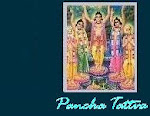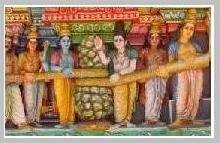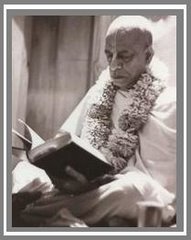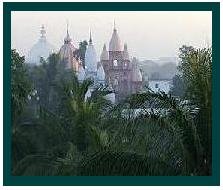
"If I am sincere in my search for God, then God will also come to me from his side, and where we meet, he should be considered Guru."
- Bhakti Rakshak Srila Sridhar dev goswami -
"Athato Brahma-Jijnasa.. Now in this human form of life, inquire about the absolute truth". - Vedanta Sutra -
 What right does Krishna have to mandate authority over Radha? Isn't Radha the real queen of Vrindavan the Sovereign ruler of the land ?
What right does Krishna have to mandate authority over Radha? Isn't Radha the real queen of Vrindavan the Sovereign ruler of the land ?
 Paurnamasi Devi is the gatekeeper of Seva Kunj.
Paurnamasi Devi is the gatekeeper of Seva Kunj.

 Graffiti (singular: graffito; the plural is used as a mass noun) is the name for images or lettering scratched, scrawled, painted or marked in any manner on property. Graffiti is any type of public markings that may appear in the forms of simple written words to elaborate wall paintings. Graffiti has existed since ancient times.
Graffiti (singular: graffito; the plural is used as a mass noun) is the name for images or lettering scratched, scrawled, painted or marked in any manner on property. Graffiti is any type of public markings that may appear in the forms of simple written words to elaborate wall paintings. Graffiti has existed since ancient times.



 The goal of the eyes is to see someone like you; the goal of the skin is to embrace the body of one such as you. The goal of the tongue is to sing the glories of one such as you, for great devotees of the Lord are rare in this world.
The goal of the eyes is to see someone like you; the goal of the skin is to embrace the body of one such as you. The goal of the tongue is to sing the glories of one such as you, for great devotees of the Lord are rare in this world. s mentioned in the Purāṇas and Mahābhārata etc. are actual history not only of this planet but also of the other millions of planets within the universe. Some times the history of planets beyond this world appear to such men of poor fund of knowledge, as some thing nonbelievable. But they do not know that different planets are not equal in all respects and as such some of the historical facts derived from other planets do not correspond with the experience of this planet. Considering the different situation of different planets as also time and circumstances, there is nothing wonderful in the stories of the Purāṇas, nor are they imaginary. We should always remember the maxim that one man's food is another man's poison. We should not therefore reject the stories and histories of the Purāṇas as imaginary. The great ṛṣis like Vyāsa had no business to put some imaginary stories in His literatures.
s mentioned in the Purāṇas and Mahābhārata etc. are actual history not only of this planet but also of the other millions of planets within the universe. Some times the history of planets beyond this world appear to such men of poor fund of knowledge, as some thing nonbelievable. But they do not know that different planets are not equal in all respects and as such some of the historical facts derived from other planets do not correspond with the experience of this planet. Considering the different situation of different planets as also time and circumstances, there is nothing wonderful in the stories of the Purāṇas, nor are they imaginary. We should always remember the maxim that one man's food is another man's poison. We should not therefore reject the stories and histories of the Purāṇas as imaginary. The great ṛṣis like Vyāsa had no business to put some imaginary stories in His literatures. histories is that they are all connected with activities of the Lord in a different time and atmosphere. Śrīla Śukadeva Gosvāmī is the topmost personality of all the self-realized souls and he accepted as subject matter of studies from his father Vyāsadeva. Śrīla Vyāsadeva is the great authority and the subject matter of Śrīmad-Bhāgavatam being equally important, he delivered the message first to his great son Śrīla Śukadeva Gosvāmī. It is compared with the cream of the milk. Vedic literatures are like the Milk Ocean of knowledge. Cream or butter is the most palatable essence of milk and so also is Śrīmad-Bhāgavatam as it contains all palatable, instructive and authentic versions from different activities of the Lord and His devotees.
histories is that they are all connected with activities of the Lord in a different time and atmosphere. Śrīla Śukadeva Gosvāmī is the topmost personality of all the self-realized souls and he accepted as subject matter of studies from his father Vyāsadeva. Śrīla Vyāsadeva is the great authority and the subject matter of Śrīmad-Bhāgavatam being equally important, he delivered the message first to his great son Śrīla Śukadeva Gosvāmī. It is compared with the cream of the milk. Vedic literatures are like the Milk Ocean of knowledge. Cream or butter is the most palatable essence of milk and so also is Śrīmad-Bhāgavatam as it contains all palatable, instructive and authentic versions from different activities of the Lord and His devotees. When Srila Vyasa Dev was compiling the Vedas he was confronted with some dissatisfaction of mind. Just at that moment he was visited by his Spiritual Master Jagat Guru Srila Narada Muni who advised him in many ways as to what to write that would benefit souls who are searching for enlightenment in the coming age. The following commentary is found in the Original Srimad Bhagwatam (1.6.11) translated from Sanskrit to English by A.C Bhaktivedanta Swami.
When Srila Vyasa Dev was compiling the Vedas he was confronted with some dissatisfaction of mind. Just at that moment he was visited by his Spiritual Master Jagat Guru Srila Narada Muni who advised him in many ways as to what to write that would benefit souls who are searching for enlightenment in the coming age. The following commentary is found in the Original Srimad Bhagwatam (1.6.11) translated from Sanskrit to English by A.C Bhaktivedanta Swami. Man's activities in the fields of agriculture, mining, farming, industries, gardening all were on the same scale, as they are now, even previous to the present creation and the same activities will remain as they are even in the next creation. After many hundreds of crores of years one creation is annihilated and after many hundreds of crores of years anoth
Man's activities in the fields of agriculture, mining, farming, industries, gardening all were on the same scale, as they are now, even previous to the present creation and the same activities will remain as they are even in the next creation. After many hundreds of crores of years one creation is annihilated and after many hundreds of crores of years anoth er creation is started by the law of nature and the history of the universe repeats itself practically on the same level but the mundane wranglers waste time in the matter of archaeological excavations without any search into the vital necessities of life. Śrī Nārada Muni, even though he was a mere child, after getting an impetus of spiritual renaissance did not waste time for a single moment in the matter of economic development although he passed on through the societies of towns and villages, mines and industries but continually went on for progressive spiritual emancipation. Śrīmad-Bhāgwatam is nothing but another repeating of history which happened some hundreds of crores of years before. As it is said herein before that in the Srimad Bhagwatam only the most important factors of history, historical narration are picked up so it is recorded in this transcendental piece of literature.
er creation is started by the law of nature and the history of the universe repeats itself practically on the same level but the mundane wranglers waste time in the matter of archaeological excavations without any search into the vital necessities of life. Śrī Nārada Muni, even though he was a mere child, after getting an impetus of spiritual renaissance did not waste time for a single moment in the matter of economic development although he passed on through the societies of towns and villages, mines and industries but continually went on for progressive spiritual emancipation. Śrīmad-Bhāgwatam is nothing but another repeating of history which happened some hundreds of crores of years before. As it is said herein before that in the Srimad Bhagwatam only the most important factors of history, historical narration are picked up so it is recorded in this transcendental piece of literature. The Appearance Day of Srila Bhaktisiddhanta Sarasvati is observed on February 1st. This glorification is from HDG A.C. Bhaktivedanta Swami Srila Prabhupada's 'Back To Godhead', Volume 1, Part 9, March 1952.
The Appearance Day of Srila Bhaktisiddhanta Sarasvati is observed on February 1st. This glorification is from HDG A.C. Bhaktivedanta Swami Srila Prabhupada's 'Back To Godhead', Volume 1, Part 9, March 1952.Om Vishnupada Sree Sreemad Bhakti Siddhanta Saraswati Goswami appeared in this mortal world in the year in February on as the third son of Srila Bhaktivinode Thakur known as Late Kedarnath Dutt in His early householder life. Srila Bhakti Siddhanta Saraswati was known as Bimala Prasad Dutt in His early life and from His very boyhood, inspired by His devotee father, lived a strict pious and religious life. One instance in His early life will prove how much He was rigid in His principle of religious way of life. The instance may be cited here as a matter of course. Srila Kedar Nath Dutta as an ideal Grihastha used to worship Sree Sree Radha Govinda Vigraha at his house. As such one day he purchased some good quality mangoes for the deity when Srila Bhakti Siddhanta Saraswati was a mere child. The child Bimala Prasad pretending the childish nature ate up the mangoes without the knowledge of His father. The father when he came to know that the mangoes purchased for offering to the deities at his house were swallowed up by his child Bimala Prasad, he mildly rebuked Him and warned Him also not to commit the mistake in future. The child Bimala Prasad took up this matter very seriously and as the proverb goes that child is the father of future men, so He proved Himself then as the future Acharya of the human community.
From that day forward till His departure from this mortal world He remembered that mistake which He had committed in His early life and as a matter of self imposed punishment He never touched mangoes of any kind for His eating purpose. In His later life He was so many times requested by His thousands and thousands disciples to accept mangoes but He always reminded of His childish so called mistake and always quoted the instruction from the Ishopanishad that everything belongs to the Almighty God. No body therefore accept anything in this world unless the same has first been offered to Him (Almighty God).
Another instance of His early life may be stated here that when Bimala Prasad was on the lap of his beloved mother His father Late Kedar Nath Dutta was posted as Magistrate of Puri. The Car festival of Sree Sree Jagannathji took place at that time. The house was situated just near the main road through which the Car used to pass. So when the Car was moving it stopped all of a sudden in front of the house where Sri Bimala Prasad was on the lap of His mother. The Car of Jagannath stopped and did not move with utmost endeavour of the pulling devotees. The mother of Bimala Prasad took this opportunity and was helped to get up on the Car for Darshan of the Deity with her saintly son. The baby Bimala Prasad was then thrown on the holy feet of Sree Sree Jagannathji and at once the baby was blessed by the God as some flowers fell down on the baby from the hands of the Deity. After this incidence the Car began to move and every intelligent person present there could understand that the child Bimala Prasad was not an ordinary one.
There are many such small but very significant instances from His very childhood which indicated Bimala Prasad to be a future great personality and it so happened that in His later age He became the most powerful Acharya in the line of Gaudiya Vaishnava Sampradaya in the disciplic succession from the Madhyacharya who was in the line of Brahma Sampradaya coming down Brahma the Creator of this Universe. There are four Sattawata or transcendental spiritual Acharya Sampradayas or fundamental schools of Theism such as the Brahma Sampradaya beginning from Brahma after His initiation from the Personality of Godhead; the Rudra Sampradaya beginning from Sankara or Mahadeva; the Shree Sampradaya beginning from Sreemati Luxmi Devi the Eternal Consort of Shree Narayana and the Kumar Sampradaya beginning from the Kumar namely Sanak Sanat Kumars. Sree Madhyacharya belonged to Brahma Sampradaya, Sree Ramanuja to the Sree Sampradaya, Sree Vishnuswami to the Rudra Sampradaya and Sree Nimbarka belonged to Kumar Sampradaya. All these four Acharyas are bonafide preachers of the pure transcendental philosophy dealing with the problems of the world, the living entities and the Almighty God who is the Father of the creation as well as the living entities who are falsely trying to dominate over the creation and the controlling energy known as the material Nature.
Sree Bhakti Siddhanta Saraswati Goswami Maharaj happened to be the tenth generation in the line of disciplic succession from Lord Chaitanya who accepted Srila Iswar Puri as His spiritual Master. Srila Madhabendra Puri was the spiritual Master of Srila Iswar Puri and He (Sri Madhabendra Puri) belonged to be in the disciplic succession from Madhyacharya who was direct disciple of Sree Vyasdeva. The Spiritual Master of Srila Vyasdeva was Srila Narada Muni who was directly initiated by Brahma the originator of the Brahma Sampradaya and therefore my spiritual Master Sree Sreemad Bhakti Siddhanta Saraswati Goswami Maharaj belonged to the transcendental spiritual school of philosophy of the Brahma Sampradaya linking Brahma to Vyasdeva; from Him to Madhyacharya, from Madhyacharya to Lord Chaitanya and from Lord Chaitanya to Himself in a systematic principle of disciplic succession as stated in the Bhagwat Geeta.
Ebam Parampara Paraptam etc.
As a bonafide Acharya of the Brahma-Madhya-Gaudiya Sampradaya the mission of Sree Sreemad Bhakti Siddhanta Saraswati Goswami was to re-establish the pure form of theism as propounded by Lord Chaitanya in the line of His predecessors. Lord Chaitanya preached only the teachings of Bhagwat Geeta in the most practical way to suit the present environment created by the dark age of quarrel and fight. In the latter-age calculated to be two hundred years before the advent of Srila Bhakti Siddhanta Saraswati Goswami Maharaj many pseudo-spiritualistic parties in the name of Lord Chaitanya grew up like mushrooms to exploit the noble sentiment of spiritualism of the innocent people of Earth. Such pseudo-spiritualistic parties deviated poles asunder from the preaching of Lord Chaitanya because they were unfit to undergo the disciplic regulations and as such they had mitigated a via-media principle of rotten materialistic idea with pure spiritualism.
They misunderstood the highest form of worship contemplated by the Gopies of Brindaban in the transcendental loving pastimes of Lord Shree Krishna and misidentified the spiritual process with a materialistic idea of erotic principle. As such the highest principle Rashlila stated in the Bhagwat to be understood and relished at the stage of the Paramhansas was made a plaything by such pseudo parties are known as the Oal, Baoul, Nera, Karta Bhaja, Sain, Darbesi Sakhi-vekhi, Sahajia, Caste Goswamins, Caste Brahmins and so on. These pseudo parties passed as the disciples of Lord Chaitanya with their cheap nefarious activities and of all the above parties the Sahajias and the Caste Goswamins became the most obstinate obstructors to the onward progress of the universal movement of Lord Chaitanya.
The Philosophy of Lord Chaitanya was that God is One without a second. He is known as Shree Krishna but His incarnations such as Rama Nrisingha are all identical with Him. The living entities or Jivas are qualitatively one with Godhead but quantitatively they are innumerable but eternal servitors of the Supreme Personality of Godhead. The present materialistic activities of the Jivas are to be understood as the acts of Maya or illusion and therefore they are all waste of energy of the human being. The energy of the human being as also of other living being should therefore be directed under the bonafide regulations of the Acharya so the line of Lord Chaitanya and as such He vehemently protested against the principles of those pseudo transcendentalists now passed in the name of Lord Chaitanya.
Srila Thakur Bhaktivinode initiated the reformatory movement by literary contributions while he was still engaged as a high Government Officer. During his householder life and serving as a Magistrate he wrote books of various descriptions in Bengali, English, Sanskrit & etc. to present an actual picture of pure devotional activities of Lord Chaitanya. Srila Bhakti Siddhanta Saraswati Goswami Maharaj got inspiration from his very Childhood all about Srila Thakur Bhaktivinode's movement. As a matter of fact out of all his other son's Srila Saraswati Thakur practically worked as the private secretary of Srila Bhaktivinode Thakur as such Bhaktivinode Thakur gave Him (Srila Saraswati Thakur) the transcendental Power of Attorney to espouse the cause of Lord Chaitanya and so after Srila Bhaktivinode Thakur's departure—Srila Saraswati Thakur took up reins of that reformatory movement.
The first and foremost task of Srila Saraswati Thakur was to excavate the holy birth-place of Lord Chaitanya at Sreedham Mayapur in the district of Nadia in West Bengal. To substantiate this preliminary act of His great future movement Srila Saraswati Thakur had to face tremendous difficulties offered by the caste goswamins at Nabadwip—because they apprehended a lawyer in that initial movement. The caste goswamins were exploiting and still are exploiting the religious sentiments of the common people in the name of Lord Chaitanya and presented themselves as so called relative and descendants of Lord Chaitanya and Lord Nityananda. Factually Lord Chaitanya or for the matter of that Lord Nityananda accepted nobody as their relative or kinsmen who were not devotee of the Lord. On the contrary Lord Chaitanya accepted Thakur Haridas, who happened to come out of a Mohammedan family, as the Namacharya or the most powerful authority for preaching the samkirtan movement which Lord Chaitanya inaugurated so arduously.
Lord Chaitanya, as it is stated in the Bhagwat Geeta or in other authentic scriptures, wanted to re-establish the Vaishnava Dharma on the real basis of spiritualism. He never deprecated the natural caste system but neither He approved of the birth-right caste system, which has degenerated into slut of anachronism. Lord Chaitanya opined that anyone who is well conversant with the philosophy of the Absolute Truth Shree Krishna, never mind what he is either a born Brahmin or Sudra or in the Ashram of a Sanyasi or Grihastha, is perfectly competent to act in the role of Spiritual Master. And He practically demonstrated this fact during His preaching work.
The caste goswamins assisted by the other pseudo-transcendentalists made a clique to check up the universal movement of Lord Chaitanya and made a business of dispatching those foolish followers to the kingdom heaven after having drawing a lumpsum amount for this priestcraft hooliganism.
Sree Sreemad Bhakti Siddhanta Saraswati Goswami Maharaj wanted to check up this pseudo-spiritualistic activities of the so-called followers of Lord Chaitanya and present the actual thing for acceptance by the general public religionists and modern philosophers for a critical study of the sublime gift of Lord Chaitanya. It is the honest belief of Srila Saraswati Thakur that people in general, modern philosophers and thinkers as also the religionists will be struck with wonder when they seriously make a study of the gift of Lord Chaitanya.
What was thought by modern leaders like Gandhi and Rabindranath was long long before thought by Lord Chaitanya not as a public leader of political aspiration but as the Father of all living entities. The movement of Lord Chaitanya is generally known as the Samkirtan movement which is a transcendental process of self-realisation by removing the dust of materialism on the mirror of human intelligence. The present problem confronting the human civilization is due to lack of a proper introspection of the goal of human knowledge.

















